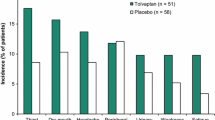Abstract
A 27-year-old Turkish male presented with fatigue, long lasting hypertension, hyperkalemia, hyperchloremic metabolic acidosis and normal glomerular filtration rate. His brother also showed hyperkalemia with no other features of the disease. Plasma renin levels were low and serum aldosterone levels were inappropriately low-normal to his hyperkalemia. Plasma cortisol levels were normal. Plasma renin aldosterone levels responded appropriately to postural changes, salt restriction and saline infusion. Fludrocortisone was ineffective in his hyperkalemia. The conditions were consistent with Type II pseudohypoaldosteronism (PHA). Furosemide and sodium bicarbonate were effective to control his hyperchloremia, metabolic acidosis and hypertension but partly effective for his hyperkalemia. dDAVP alone did not control the situation and hypertension and metabolic derangement reoccurred. Adding dDAVP to furosemide and sodium bicarbonate successfully controlled hyperkalemia, hyperchloremic acidosis and hypertension. The patient stayed normotensive with normal metabolic and biochemical parameters after 6 months with furosemide and dADVP although sodium bicarbonate had been discontinued after the first month of therapy. dDAVP is a useful adjunct to furosemide and non chloride anions which altogether successfully reverse the metabolic derangement in Type II PHA.
Similar content being viewed by others
References
Melby J.C., Azar ST. Hypoaldosteronism and mineralocorticoid resistance. In: De Groot L.J. (Ed.), Endocrinology. W.B. Saunders Company, Philadelphia, Pennsylvania, 1995, vol 2, p. 1808.
Paver W.K.A., Pauline G. Hypertension and hyperpotassemia without renal disease in a young male. Med. J.Austr. 2: 305, 1964.
Arnold J.E., Healy JK. Hyperkalemia, hypertension and systemic acidosis without renal failure associated with a tubular defect in potassium excretion. Am. J. Med. 47: 461, 1969.
Gordon R.D., Gedees R.S., Pawsey C.G.K., O’Halloran W.O. Hypertension and severe hyperkalemia associated with suppression of renin and aldosterone and completely reversed by dietary sodium restriction. Med. J. Austr. 4: 287, 1970.
Schambelan M., Sebastian A., Rectce F.C. Jr. Mineralocorticoid resistant renal hyperkalemia without salt wasting (type II pseudohypoaldosteronism) role of increased renal chloride reabsorption. Kidney Int. 19: 716, 1981.
Nahum H., Paillard M., Prigent A., Leviel F., Bichara M., Gardin J.P., Idatte J.M. Pseudohypoaldosteronism type II: Proximal renal tubular acidosis and dDAVP-sensitive renal hyperkalemia. Am. J. Nephrol. 6: 253, 1986.
Field M.J., Stanton B.A., Giebisch G.H. Influence of ADH in renal potassium handling a micropuncture and micro perfusion study. Kidney Int. 25: 502, 1984.
Elalouf J.M., Roinel N., Rouffignac C. Effects of antidiuretic hormone on electrolyte reabsorption and secretion in distal tubules of rat kidney. Pflugers Arch. 401: 167, 1984.
Brautbar N., Levi J., Rosier A., Leitesdorf E., Djaldeti M., Epstein M., Kleeman C.R. Familial hyperkalemia, hypertension and hyporeninemia with normal aldosterone levels. A tubular defect in potassium handling. Arch. Intern. Med. 138: 607, 1978.
Tormey W.P., Morgan D.B. Etiological Considerations in Gordon’s Syndrome: Possible role of prostaglandins. Prostaglandin’s Med. 4: 107, 1980.
Tomita K., Pissano J.J., Knepper M.A. Effects of vasopressin and bradykinin on sodium and potassium transport in rat cortical collecting ducts in vitro. Proceedings of the 17 th Annual Meeting of the American Society of the Nephrology. Washington 1984, p. 223.
Battle D.C., Rowe S., Gutterman C., Von Riote A. Vasopressin administration as a tool to investigate K secretion by the cortical collecting tubule (Abstract). Clin. Res. 33: 476, 1985.
Sonnerberg H., Honrath U., Wilson D.R. Effect of vasopressin analogue (dDAVP) on potassium transport in medullary connecting duct. Am. J. Physiol. 252: F 986, 1987.
Author information
Authors and Affiliations
Rights and permissions
About this article
Cite this article
Erdoǧan, G., Çorapçioǧlu, D., Erdoǧan, M.F. et al. Furosemide and dDAVP for the treatment of pseudohypoaldosteronism Type II. J Endocrinol Invest 20, 681–684 (1997). https://doi.org/10.1007/BF03348032
Accepted:
Published:
Issue Date:
DOI: https://doi.org/10.1007/BF03348032




